 ...........................................................................................................
...........................................................................................................
Subregion IIb – Southern Aegean
The Neolithic period in the southern Aegean region
Similar to the "Preceramic Period" in Thessaly, J. D. Evans and Th. Jacobsen described also for southern Greece, at the sites of Knossos and Franchthi, an early stage of the Neolithic Age without pottery. Other than V. Milojčić and D. Theocharis conceived of the "Preceramic" (compare Analysis IIc), Evans invoked with the term "Aceramic" that this period was not preceding the Ceramic Neolithic but was co-eval with it (Evans in Warren et al. 1968, 271). In this assessment he was supported by J. Mellaart according to whom a short Aceramic phase existed in Hacılar alongside ceramic phases elsewhere (Mellaart 1970, 6). In their view, at some sites ceramic containers were obviously not deemed useful by the inhabitants and only the next generations integrated this innovation into their daily life. Such Aceramic sites, nevertheless, seem to be the exception rather than the rule in the Aegean area, since at most sites dating to the mid-7th millennium calBC, including Çukuriçi, Barcın Höyük, Paliambela, Mavropigi and Argissa Magoula, pottery was in use, although in small quantities (compare Reingruber 2015).
The southern Aegean includes only few sites with relevant 14C sequences, among them the two above mentioned sites of Franchthi and Knossos. A new body of dates from the site of Kouphovouno represents the MN and early LN of the 6th millennium BC. The Late Neolithic of the 5th millennium is reflected in the dates from Kastria, Kitsos and Knossos. No dates are available from the important sites of Corinth, Lerna, Dendra, Nemea and Prosymna.
Franchthi
The Neolithic dates from the Franchthi span the period between c. 6700 and 4000 BC (Figure 1). A short early phase anywhere between 6700 and 6400 BC is representing the transition from the Mesolithic to the Neolithic (compare Figures 3 and 4 in Analysis IIa–d). It is followed by the early Franchthi Ceramic Phase 1 (FCP1) with three dates:
- Date P-1525 is from trench FF1 – a trench that most of the authors have excluded from their evaluations (compare Vitelli 1993, 40, note 5) because of strong disturbances in post-Neolithic times. This date coincides with the group of dates from Lithic Phase X ("Initial Neolithic").
- Another charcoal sample (P-1667) is also deriving from a trench with many disturbances (trench H).
- The only sample from a reliable context and part of a largely undisturbed stratigraphical succession is P-2093 from trench FAS. It is dating phase FCP1 to the beginning of the 6th millennium BC.
In the interpretation of the dates from Franchthi we follow Vitellis' cautioning for trench FF1 and put more emphasis on the date from FAS, although this (methodological safe) approach did not remain without critique (Perlès et al. 2013, 2003). Moreover, the sample P-2093 coincides well with the ensuing sequences from FCP2 and FCP3 (c. 5750–5500 BC) antedating it by c. 50 years. Thus, between Lithic Phase X and the early pottery phase FCP1 a gap of at least 500 years has to be acknowledged.
The Neolithic dates coincide well with the dates obtained from drillings in the Koilada Bay: an early date around 6650–6250 partly overlaps with the dates for the "Initial Neolithic" at 6700–6400 calBC; the other four dates cover the time between c. 5800 and 5000 calBC. The years around 5800 BC for the beginning of a Neolithic sequence are reported also from Kouphovouno (infra).
The dates for the first three Franchthi Ceramic Phases (FCP1, FCP2 and FCP3) overlap between c. 5900 and 5500 BC (the time of the MN in Thessaly), followed again by a gap before the Late Neolithic phase FCP4 starts at c. 5200 BC. After another gap of 1000 years, two dates attest to a Final Neolithic (Chalcolithic) occupation in FCP5 at 4200–3900 BC.
Major gaps are thus acknowledgeable in the Franchthi sequence. Of major interest here is the gap of c. 500 years between the earliest Neolithic occupation of the cave and its re-occupation around or after 5900 calBC. It coincides with the EN in Thessaly between 6400 and 6000 calBC (compare Analysis of Subregion IIc). Therefore, the terminology applied in Franchthi with an Early Neolithic phase is only of local relevance, the phases FCP1–3 being co-eval with the Middle Neolithic in Thessaly and the Early Chalcolithic in Anatolia.
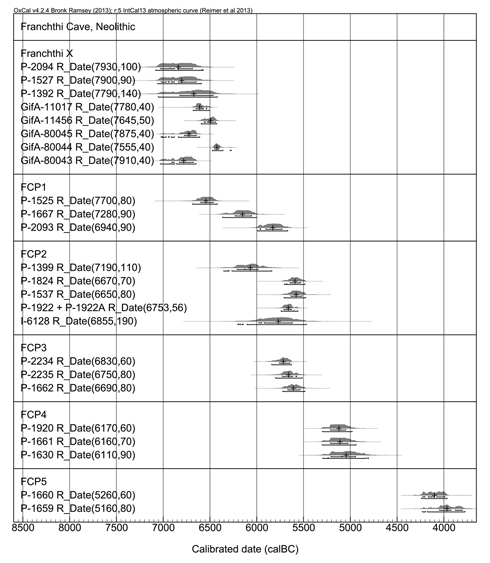
Knossos
A total of 36 dates derive from the Neolithic levels in Knossos, with 19 dates from the excavations led by J. D. Evans in the late 1950s. 17 new dates from the excavation in 1997 led by N. Efstratiou were either dated conventionally in Athens (DEM-) or with AMS in Oxford (Facorellis and Maniatis 2013, 193).
From Evans excavations three dates (BM-124, BM-278, and BM-436) were obtained from the basal level Knossos X. They were thought to date the beginning of the occupation around 7000 calBC (Figure 2). The BM-dates display very high standard deviations, not making them suitable for detailed analysis. Among them, only one date was run on short-lived material (BM-436). This date on grains was re-assigned to level IX by Evans (1994, 5), which is in deviation of all previous publications of the date (e.g., Evans 1968, 269, 272; Evans 1971, 117), and not followed here. Nevertheless, it occurs that from the group of dates assigned to the Aceramic period of the 7th millennium it is the most reliable one. It was associated with the carbonized wood sample BM-278 that is up to 500 years older (Facorellis and Maniatis 2013, 196, tab. 10.2), reminding us of the troubles related to wood, especially oak-samples, liable of the old-wood-problem (heartwood, the major part of an oak-log, might have been many centuries old by the time the tree was felled).
The oak sample from 1960 ("Sample 1": BM-124 + BM-278) and the only deciduous oak sample from 1997 (OxA-9215, Figure 3) were both found in the Central Court and gave the same age. Due to the many wiggles in the calibration curve resulting in a plateau at the beginning of the 7th millennium, these two oldest dates span three centuries and, hence, distort our perception of the possible beginning of the Neolithic at this site: it is just as probable that the dated parts of the oak-tree were growing around 6700 instead of 7050 calBC, and it is as possible that the tree(s) had been cut only centuries later.
The sample for OxA-9215 (Figure 3) stems from a deciduous oak; other than is the case with the dates from the 1960s, this single date cannot be supported by any other short-lived sample (Figure 4), and there are no compelling reasons to rely on this high date alone for dating the beginning of level 39, not to speak of the Aceramic Neolithic period in Knossos in general.
Contrary to the conclusions drawn by Facorellis and Maniatis 2013, 199 it is therefore not at all assured that the "radiocarbon dating has established absolute dates for the beginning of the Neolithic in Crete at 7030–6780 BC". The ambiguous dates OxA-9215 and the R_combined date BM-124 + BM-278 cannot be accepted for dating the beginning of the Neolithic in Knossos, not to speak of the beginning of the Neolithic Age in the whole of Crete – being from long-lived oak, they provide only a TPQ. Much more reliable is the date on grain (BM-436) at 6770–6430 calBC, that is in accordance with the new dates from other sites in the Southern Aegean (Franchthi, Çukuriçi Höyük and Ulucak).
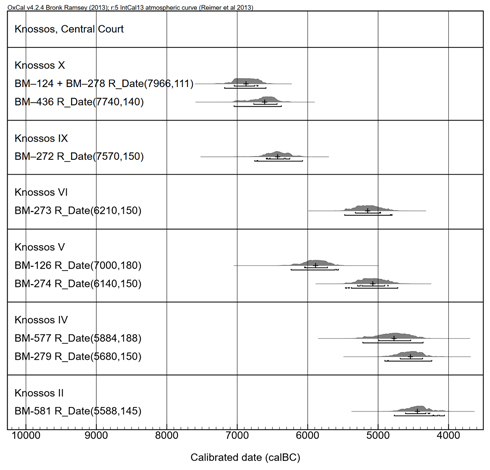
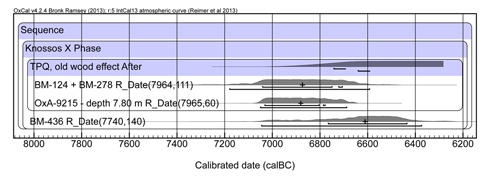
The two dates BM-272 from Knossos IX (Figure 2) and DEM-660 from level 29 (Figure 4) are falling into the second half of the 7th millennium BC:
- Together with the other BM dates from the 6th and even 5th millennium, BM-272 was assigned to the "EN I". Since it was described as deriving from the bottom of level 24, "immediately overlying earliest camp occupation above bedrock" (Barker et al. 1969, 279), one cannot rule out that it is dating the same event as is the date on grain (BM-436) with which it is overlapping at 1σ at 6590–6430 calBC. No dates are available from levels VIII–VII, the sequence continuing with the dates from level VI at the end of the 6th millennium.
- The date DEM-660 is from level 29 (1997-Tr. II) that, according strictly by depth, should belong to around 5000 calBC instead of 6250–6090 calBC. And indeed, from the same level 29 and the exactly same depth of 4.25 m derives the 1350 years younger date OxA-9218 (4950–4800), confirming its interpretation as outlier. Facorellis and Maniatis 2013, 199 offer "some form of disturbance" for explaining this difference.
Due to these inconsistencies, a modelling of the dates is not advisable. Either do these two 6th-millennium dates reflect a short re-occupation of the site (but where are the related finds?) or the dates are outliers and the re-occupation indeed started only in the middle or late 6th millennium – consistent with the pottery that is in a circum-Aegean comparison of LN times. This view is supported by the sequences from the two other trenches:
1. Trench II-1997: when the dates are arranged according to depth they indeed reflect a rough pattern of decreasing age the higher up they derive from. The dates OxA-9219, DEM-670, DEM-660, DEM-641, and DEM-638 are contradicting the depths and stratigraphy and could be treated as anomalous. The other dates are forming two groups, one clustering before 5000, the other after 5000 calBC (Figure 4). In this model, the start of the Knossos LN is at 5220–5080, the end at 4920–4810 (medians 5160, 4850 resp.).
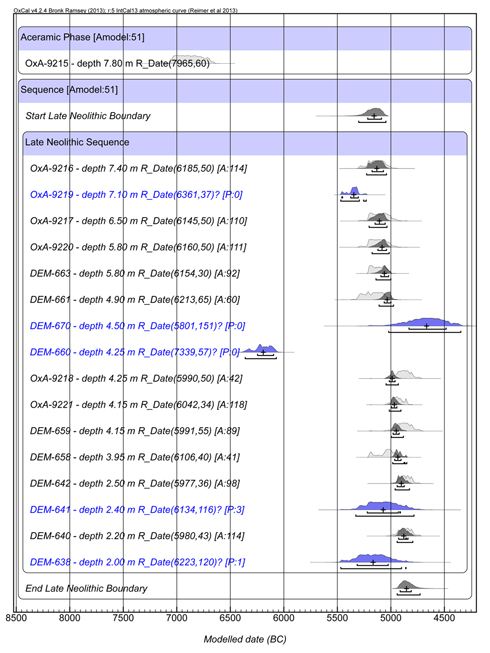
2. The interpretation that the re-occupation in Knossos started after a long gap of possibly more than 1000 years is well supported also by the sequence from the West Court obtained in the 1970s–80s (Figure 5). Here, the "EN I" started in the middle or late 6th millennium (comparable to Trench II-1997), the "EN II", "MN" and "LN" being of the 5th millennium BC.
No matter which model will be proven by the new series of dates in preparation (pers. comm. Peter Tomkins, May 30, 2015): a) that of a continuous occupation since the mid-7th millennium BC; b) that of short re-occupations events in the late 7th millennium or c) that of a major gap of more than 1000 years between the Aceramic level and the "EN I", the relative chronological system of Knossos has to be re-evaluated in a general Aegean perspective. The applied terminology is therefore viable only in a local relative chronological system, as is the case on the Peloponnese as well (supra), the local phase EN I is contemporary with the LN in the Aegean. The dates from three excavation areas (Central Court, Western Court, Trench II-1997) suggest that the Neolithic sequence started again only after 5300 calBC, with the phase labelled EN I.
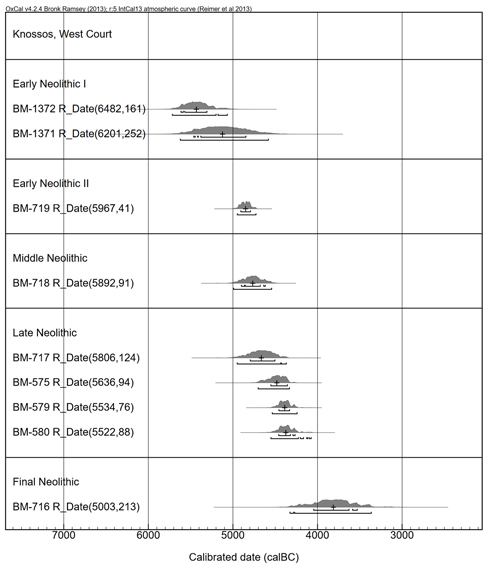
Kouphovouno
The excavations in Kouphovouno, just south of Sparta, started anew in 1999. Carbonized seeds chosen from secure contexts in stratified sequences have been dated to the 6th millennium calBC (Figure 6). According to the median values, the occupation started in the MN around 5800 BC and ended at 5530 BC (thus, coeval with the developed MN in Thessaly). After an interruption of up to 150 years, the LN I lasted until c. 5100 BC.
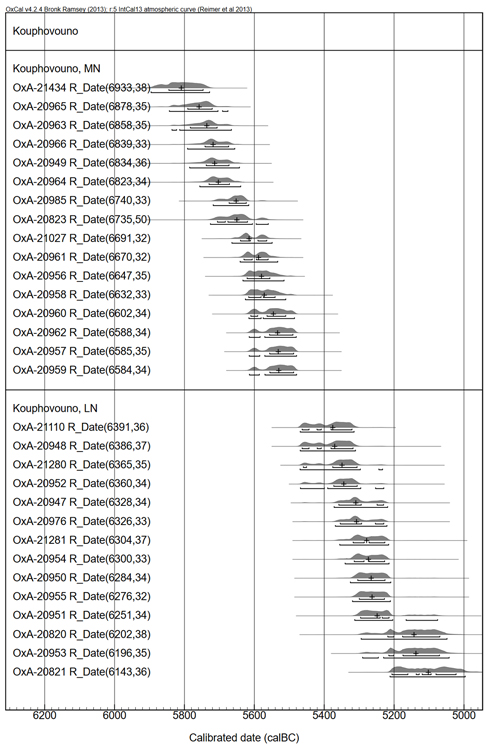
General assessment
For the Neolithic of the southern Aegean region until now no conclusive sequence exists for the time between 6500 and 6000 BC. The so-called Early Neolithic date from Franchthi (phase FCP1) coincides with the Middle Neolithic in Thessalian terminology (dating there between 6000 and 5500 calBC). The so-called Early Neolithic dates from Knossos cover the Late Neolithic; the so-called Middle and Late Neolithic dates from Knossos of the 5th millennium BC are co-eval with the Final Neolithic or Chalcolithic.
Therefore, the southern Aegean terminology is only of local relevance. More radiocarbon dates are awaited from the Alepotrypa Cave (pers. comm. William Parkinson, May 2015) that might fill in some of the gaps occurring in the southern Aegean Neolithic sequences.
The Neolithic period in the southern Aegean region
Similar to the "Preceramic Period" in Thessaly, J. D. Evans and Th. Jacobsen described also for southern Greece, at the sites of Knossos and Franchthi, an early stage of the Neolithic Age without pottery. Other than V. Milojčić and D. Theocharis conceived of the "Preceramic" (compare Analysis IIc), Evans invoked with the term "Aceramic" that this period was not preceding the Ceramic Neolithic but was co-eval with it (Evans in Warren et al. 1968, 271). In this assessment he was supported by J. Mellaart according to whom a short Aceramic phase existed in Hacılar alongside ceramic phases elsewhere (Mellaart 1970, 6). In their view, at some sites ceramic containers were obviously not deemed useful by the inhabitants and only the next generations integrated this innovation into their daily life. Such Aceramic sites, nevertheless, seem to be the exception rather than the rule in the Aegean area, since at most sites dating to the mid-7th millennium calBC, including Çukuriçi, Barcın Höyük, Paliambela, Mavropigi and Argissa Magoula, pottery was in use, although in small quantities (compare Reingruber 2015).
The southern Aegean includes only few sites with relevant 14C sequences, among them the two above mentioned sites of Franchthi and Knossos. A new body of dates from the site of Kouphovouno represents the MN and early LN of the 6th millennium BC. The Late Neolithic of the 5th millennium is reflected in the dates from Kastria, Kitsos and Knossos. No dates are available from the important sites of Corinth, Lerna, Dendra, Nemea and Prosymna.
Franchthi
The Neolithic dates from the Franchthi span the period between c. 6700 and 4000 BC (Figure 1). A short early phase anywhere between 6700 and 6400 BC is representing the transition from the Mesolithic to the Neolithic (compare Figures 3 and 4 in Analysis IIa–d). It is followed by the early Franchthi Ceramic Phase 1 (FCP1) with three dates:
- Date P-1525 is from trench FF1 – a trench that most of the authors have excluded from their evaluations (compare Vitelli 1993, 40, note 5) because of strong disturbances in post-Neolithic times. This date coincides with the group of dates from Lithic Phase X ("Initial Neolithic").
- Another charcoal sample (P-1667) is also deriving from a trench with many disturbances (trench H).
- The only sample from a reliable context and part of a largely undisturbed stratigraphical succession is P-2093 from trench FAS. It is dating phase FCP1 to the beginning of the 6th millennium BC.
In the interpretation of the dates from Franchthi we follow Vitellis' cautioning for trench FF1 and put more emphasis on the date from FAS, although this (methodological safe) approach did not remain without critique (Perlès et al. 2013, 2003). Moreover, the sample P-2093 coincides well with the ensuing sequences from FCP2 and FCP3 (c. 5750–5500 BC) antedating it by c. 50 years. Thus, between Lithic Phase X and the early pottery phase FCP1 a gap of at least 500 years has to be acknowledged.
The Neolithic dates coincide well with the dates obtained from drillings in the Koilada Bay: an early date around 6650–6250 partly overlaps with the dates for the "Initial Neolithic" at 6700–6400 calBC; the other four dates cover the time between c. 5800 and 5000 calBC. The years around 5800 BC for the beginning of a Neolithic sequence are reported also from Kouphovouno (infra).
The dates for the first three Franchthi Ceramic Phases (FCP1, FCP2 and FCP3) overlap between c. 5900 and 5500 BC (the time of the MN in Thessaly), followed again by a gap before the Late Neolithic phase FCP4 starts at c. 5200 BC. After another gap of 1000 years, two dates attest to a Final Neolithic (Chalcolithic) occupation in FCP5 at 4200–3900 BC.
Major gaps are thus acknowledgeable in the Franchthi sequence. Of major interest here is the gap of c. 500 years between the earliest Neolithic occupation of the cave and its re-occupation around or after 5900 calBC. It coincides with the EN in Thessaly between 6400 and 6000 calBC (compare Analysis of Subregion IIc). Therefore, the terminology applied in Franchthi with an Early Neolithic phase is only of local relevance, the phases FCP1–3 being co-eval with the Middle Neolithic in Thessaly and the Early Chalcolithic in Anatolia.

Figure 1. The Neolithic sequence from Franchthi (dates are arranged according to phases, trenches and units).
Knossos
A total of 36 dates derive from the Neolithic levels in Knossos, with 19 dates from the excavations led by J. D. Evans in the late 1950s. 17 new dates from the excavation in 1997 led by N. Efstratiou were either dated conventionally in Athens (DEM-) or with AMS in Oxford (Facorellis and Maniatis 2013, 193).
From Evans excavations three dates (BM-124, BM-278, and BM-436) were obtained from the basal level Knossos X. They were thought to date the beginning of the occupation around 7000 calBC (Figure 2). The BM-dates display very high standard deviations, not making them suitable for detailed analysis. Among them, only one date was run on short-lived material (BM-436). This date on grains was re-assigned to level IX by Evans (1994, 5), which is in deviation of all previous publications of the date (e.g., Evans 1968, 269, 272; Evans 1971, 117), and not followed here. Nevertheless, it occurs that from the group of dates assigned to the Aceramic period of the 7th millennium it is the most reliable one. It was associated with the carbonized wood sample BM-278 that is up to 500 years older (Facorellis and Maniatis 2013, 196, tab. 10.2), reminding us of the troubles related to wood, especially oak-samples, liable of the old-wood-problem (heartwood, the major part of an oak-log, might have been many centuries old by the time the tree was felled).
The oak sample from 1960 ("Sample 1": BM-124 + BM-278) and the only deciduous oak sample from 1997 (OxA-9215, Figure 3) were both found in the Central Court and gave the same age. Due to the many wiggles in the calibration curve resulting in a plateau at the beginning of the 7th millennium, these two oldest dates span three centuries and, hence, distort our perception of the possible beginning of the Neolithic at this site: it is just as probable that the dated parts of the oak-tree were growing around 6700 instead of 7050 calBC, and it is as possible that the tree(s) had been cut only centuries later.
The sample for OxA-9215 (Figure 3) stems from a deciduous oak; other than is the case with the dates from the 1960s, this single date cannot be supported by any other short-lived sample (Figure 4), and there are no compelling reasons to rely on this high date alone for dating the beginning of level 39, not to speak of the Aceramic Neolithic period in Knossos in general.
Contrary to the conclusions drawn by Facorellis and Maniatis 2013, 199 it is therefore not at all assured that the "radiocarbon dating has established absolute dates for the beginning of the Neolithic in Crete at 7030–6780 BC". The ambiguous dates OxA-9215 and the R_combined date BM-124 + BM-278 cannot be accepted for dating the beginning of the Neolithic in Knossos, not to speak of the beginning of the Neolithic Age in the whole of Crete – being from long-lived oak, they provide only a TPQ. Much more reliable is the date on grain (BM-436) at 6770–6430 calBC, that is in accordance with the new dates from other sites in the Southern Aegean (Franchthi, Çukuriçi Höyük and Ulucak).

Figure 2. Calibrated dates from Knossos, Central Court (excavations conducted by J. Evans).

Figure 3. Knossos X, with date on charred grain BM-436 as possible date of destruction (median 6610 calBC).
The two dates BM-272 from Knossos IX (Figure 2) and DEM-660 from level 29 (Figure 4) are falling into the second half of the 7th millennium BC:
- Together with the other BM dates from the 6th and even 5th millennium, BM-272 was assigned to the "EN I". Since it was described as deriving from the bottom of level 24, "immediately overlying earliest camp occupation above bedrock" (Barker et al. 1969, 279), one cannot rule out that it is dating the same event as is the date on grain (BM-436) with which it is overlapping at 1σ at 6590–6430 calBC. No dates are available from levels VIII–VII, the sequence continuing with the dates from level VI at the end of the 6th millennium.
- The date DEM-660 is from level 29 (1997-Tr. II) that, according strictly by depth, should belong to around 5000 calBC instead of 6250–6090 calBC. And indeed, from the same level 29 and the exactly same depth of 4.25 m derives the 1350 years younger date OxA-9218 (4950–4800), confirming its interpretation as outlier. Facorellis and Maniatis 2013, 199 offer "some form of disturbance" for explaining this difference.
Due to these inconsistencies, a modelling of the dates is not advisable. Either do these two 6th-millennium dates reflect a short re-occupation of the site (but where are the related finds?) or the dates are outliers and the re-occupation indeed started only in the middle or late 6th millennium – consistent with the pottery that is in a circum-Aegean comparison of LN times. This view is supported by the sequences from the two other trenches:
1. Trench II-1997: when the dates are arranged according to depth they indeed reflect a rough pattern of decreasing age the higher up they derive from. The dates OxA-9219, DEM-670, DEM-660, DEM-641, and DEM-638 are contradicting the depths and stratigraphy and could be treated as anomalous. The other dates are forming two groups, one clustering before 5000, the other after 5000 calBC (Figure 4). In this model, the start of the Knossos LN is at 5220–5080, the end at 4920–4810 (medians 5160, 4850 resp.).

Figure 4. Knossos sequence based on the Efstratiou excavation (1997). Anomalous dates in blue, contradicting the depth vs age trend.
2. The interpretation that the re-occupation in Knossos started after a long gap of possibly more than 1000 years is well supported also by the sequence from the West Court obtained in the 1970s–80s (Figure 5). Here, the "EN I" started in the middle or late 6th millennium (comparable to Trench II-1997), the "EN II", "MN" and "LN" being of the 5th millennium BC.
No matter which model will be proven by the new series of dates in preparation (pers. comm. Peter Tomkins, May 30, 2015): a) that of a continuous occupation since the mid-7th millennium BC; b) that of short re-occupations events in the late 7th millennium or c) that of a major gap of more than 1000 years between the Aceramic level and the "EN I", the relative chronological system of Knossos has to be re-evaluated in a general Aegean perspective. The applied terminology is therefore viable only in a local relative chronological system, as is the case on the Peloponnese as well (supra), the local phase EN I is contemporary with the LN in the Aegean. The dates from three excavation areas (Central Court, Western Court, Trench II-1997) suggest that the Neolithic sequence started again only after 5300 calBC, with the phase labelled EN I.

Figure 5. Calibrated dates from Knossos, Western Court (excavations conducted by J. Evans).
Kouphovouno
The excavations in Kouphovouno, just south of Sparta, started anew in 1999. Carbonized seeds chosen from secure contexts in stratified sequences have been dated to the 6th millennium calBC (Figure 6). According to the median values, the occupation started in the MN around 5800 BC and ended at 5530 BC (thus, coeval with the developed MN in Thessaly). After an interruption of up to 150 years, the LN I lasted until c. 5100 BC.

Figure 6. Sequence of dates from the MN and LN from Kouphovouno.
General assessment
For the Neolithic of the southern Aegean region until now no conclusive sequence exists for the time between 6500 and 6000 BC. The so-called Early Neolithic date from Franchthi (phase FCP1) coincides with the Middle Neolithic in Thessalian terminology (dating there between 6000 and 5500 calBC). The so-called Early Neolithic dates from Knossos cover the Late Neolithic; the so-called Middle and Late Neolithic dates from Knossos of the 5th millennium BC are co-eval with the Final Neolithic or Chalcolithic.
Therefore, the southern Aegean terminology is only of local relevance. More radiocarbon dates are awaited from the Alepotrypa Cave (pers. comm. William Parkinson, May 2015) that might fill in some of the gaps occurring in the southern Aegean Neolithic sequences.
—A.R.



 up
up